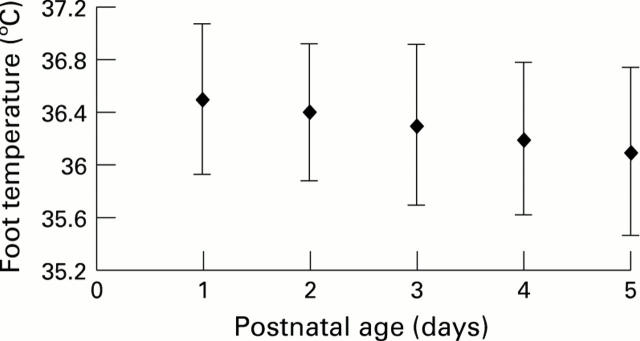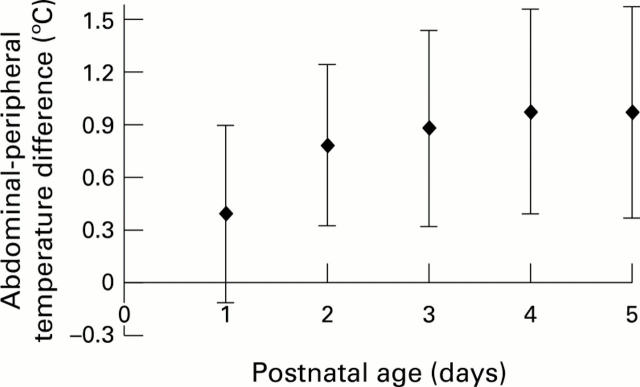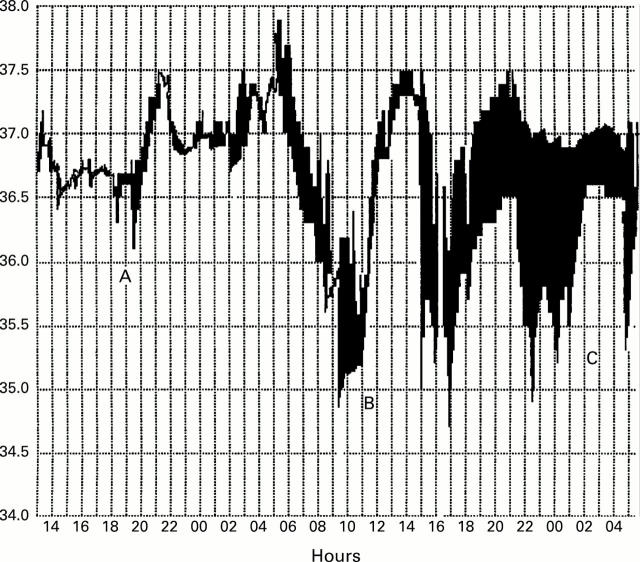Abstract
AIM—To determine ranges for skin temperatures in infants weighing under 1000 g in the first five days of life. METHOD—Abdominal skin and foot temperatures were automatically collected each second, averaged over 1 minute and stored on computer. A computer program analysed the data in 83 babies weighing under 1000 g at birth over the first five days of life and expressed the temperatures as means and standard deviation. The temperature patterns seen in these babies were also visually analysed. The relation between an increasing abdominal skin-foot temperature difference and other signs of hypovolaemia was also studied. RESULTS—These babies all had similar temperature patterns. Just after birth there was little ability to vasoconstrict in the presence of cold stress and the babies behaved more like poikilothermic animals. Vasomotor tone developed in the first three days, resulting in a stabilisation of the abdominal skin temperature to a mean of 36.90C and a widening of the central-peripheral temperature difference (Td) to a mean of 1.00 C. A Td of > 20 C was associated with other evidence of hypovolaemia for only 11% of the time. CONCLUSIONS—Infants weighing under 1000 g have poor vasomotor control at birth and are at increased risk from cold stress. After the first two to three days of life, monitoring the central-peripheral temperature difference gives an early indication of cold stress. Keywords: temperature control; central-peripheral temperature difference; hypovolaemia.
Full Text
The Full Text of this article is available as a PDF (133.4 KB).
Figure 1 .
Mean (SD) abdominal skin temperature according to postnatal age
Figure 2 .
Mean (SD) foot temperature according to postnatal age
Figure 3 .
Mean (SD) central-peripheral temperature difference according to postnatal age
Figure 4 .
Computer monitor trace of abdominal skin (top line) and foot temperatures (bottom line), with shaded area showing central-peripheral temperature difference: baby boy, gestation 26 weeks, birthweight 700 g, first 36 hours of life.
Selected References
These references are in PubMed. This may not be the complete list of references from this article.
- Ducker D. A., Lyon A. J., Ross Russell R., Bass C. A., McIntosh N. Incubator temperature control: effects on the very low birthweight infant. Arch Dis Child. 1985 Oct;60(10):902–907. doi: 10.1136/adc.60.10.902. [DOI] [PMC free article] [PubMed] [Google Scholar]
- Hey E. N., Katz G. The optimum thermal environment for naked babies. Arch Dis Child. 1970 Jun;45(241):328–334. doi: 10.1136/adc.45.241.328. [DOI] [PMC free article] [PubMed] [Google Scholar]
- Karlsson H., Hänel S. E., Nilsson K., Olegård R. Measurement of skin temperature and heat flow from skin in term newborn babies. Acta Paediatr. 1995 Jun;84(6):605–612. doi: 10.1111/j.1651-2227.1995.tb13708.x. [DOI] [PubMed] [Google Scholar]
- Merenstein G. B. Rectal perforation by thermometer. Lancet. 1970 May 9;1(7654):1007–1007. doi: 10.1016/s0140-6736(70)91139-6. [DOI] [PubMed] [Google Scholar]
- Mok Q., Bass C. A., Ducker D. A., McIntosh N. Temperature instability during nursing procedures in preterm neonates. Arch Dis Child. 1991 Jul;66(7 Spec No):783–786. doi: 10.1136/adc.66.7_spec_no.783. [DOI] [PMC free article] [PubMed] [Google Scholar]
- Morley C. J., Hewson P. H., Thornton A. J., Cole T. J. Axillary and rectal temperature measurements in infants. Arch Dis Child. 1992 Jan;67(1):122–125. doi: 10.1136/adc.67.1.122. [DOI] [PMC free article] [PubMed] [Google Scholar]
- SILVERMAN W. A., BALNC W. A. The effect of humidity on survival of newly born premature infants. Pediatrics. 1957 Sep;20(3):477–486. [PubMed] [Google Scholar]
- Sauer P. J., Dane H. J., Visser H. K. Influence of variations in the ambient humidity on insensible water loss and thermoneutral environment of low birth weight infants. Acta Paediatr Scand. 1984 Sep;73(5):615–619. doi: 10.1111/j.1651-2227.1984.tb09984.x. [DOI] [PubMed] [Google Scholar]






